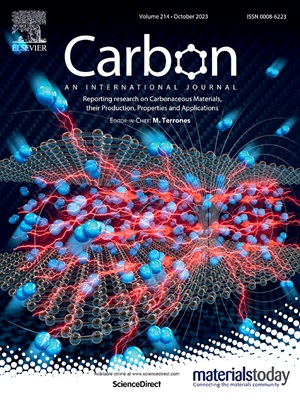Decoding structural characteristics of fluorinated graphene via Computer-Aided spectroscopic analysis
IF 11.6
2区 材料科学
Q1 CHEMISTRY, PHYSICAL
引用次数: 0
Abstract
Fluorographene, a monolayer form of carbon monofluoride, is a fluorinated graphene derivative with intriguing properties and serves as a crucial precursor for synthesizing various graphene-based materials. Understanding its structural and chemical characteristics is essential for harnessing its potential, yet many aspects of its structure remain far from fully understood. Common spectroscopic methods such as infrared spectroscopy (IR) and X-ray photoelectron spectroscopy (XPS) face challenges in precisely assigning measured binding energies and IR signals to specific atomic configurations. To address these ambiguities, we combined ab initio density functional theory calculations with experimental approaches to model spectroscopic signatures of various conformations and structural defects in fluorographene. Additionally, we investigated the structures of partially fluorinated graphene derivatives, C2F and C4F. Our theoretical insights guided the structural interpretation of an in-depth characterization of two typical commercially available graphite fluoride samples using multiple techniques, including Fourier-transformed IR, XPS with Ar+ ion beam etching, electron paramagnetic resonance, and nuclear magnetic resonance. Our findings highlight the valuable role of low-frequency IR spectroscopy and establish a foundation for identifying key structural features through a combination of theoretical calculations and spectroscopic experiments, applicable not only to fluorographene and fluorinated graphite but also in exploring structural characteristics of other two-dimensional and layered materials.

通过计算机辅助光谱分析解码氟化石墨烯的结构特征
氟石墨烯是一种单层形式的单氟化碳,是一种氟化石墨烯衍生物,具有有趣的性能,是合成各种石墨烯基材料的重要前体。了解它的结构和化学特性对于利用它的潜力至关重要,但其结构的许多方面仍远未完全了解。常用的光谱方法,如红外光谱(IR)和x射线光电子能谱(XPS),在精确地将测量的结合能和红外信号分配到特定的原子构型方面面临挑战。为了解决这些歧义,我们将从头算密度泛函理论计算与实验方法相结合,以模拟荧光素中各种构象和结构缺陷的光谱特征。此外,我们还研究了部分氟化石墨烯衍生物C2F和C4F的结构。我们的理论见解指导了使用多种技术对两种典型的商用氟化石墨样品进行深入表征的结构解释,包括傅里叶变换IR, Ar+离子束蚀刻XPS,电子顺磁共振和核磁共振。我们的研究结果突出了低频红外光谱的重要作用,并为通过理论计算和光谱实验相结合确定关键结构特征奠定了基础,不仅适用于氟石墨烯和氟化石墨,也适用于探索其他二维和层状材料的结构特征。
本文章由计算机程序翻译,如有差异,请以英文原文为准。
求助全文
约1分钟内获得全文
求助全文
来源期刊

Carbon
工程技术-材料科学:综合
CiteScore
20.80
自引率
7.30%
发文量
0
审稿时长
23 days
期刊介绍:
The journal Carbon is an international multidisciplinary forum for communicating scientific advances in the field of carbon materials. It reports new findings related to the formation, structure, properties, behaviors, and technological applications of carbons. Carbons are a broad class of ordered or disordered solid phases composed primarily of elemental carbon, including but not limited to carbon black, carbon fibers and filaments, carbon nanotubes, diamond and diamond-like carbon, fullerenes, glassy carbon, graphite, graphene, graphene-oxide, porous carbons, pyrolytic carbon, and other sp2 and non-sp2 hybridized carbon systems. Carbon is the companion title to the open access journal Carbon Trends. Relevant application areas for carbon materials include biology and medicine, catalysis, electronic, optoelectronic, spintronic, high-frequency, and photonic devices, energy storage and conversion systems, environmental applications and water treatment, smart materials and systems, and structural and thermal applications.
 求助内容:
求助内容: 应助结果提醒方式:
应助结果提醒方式:


